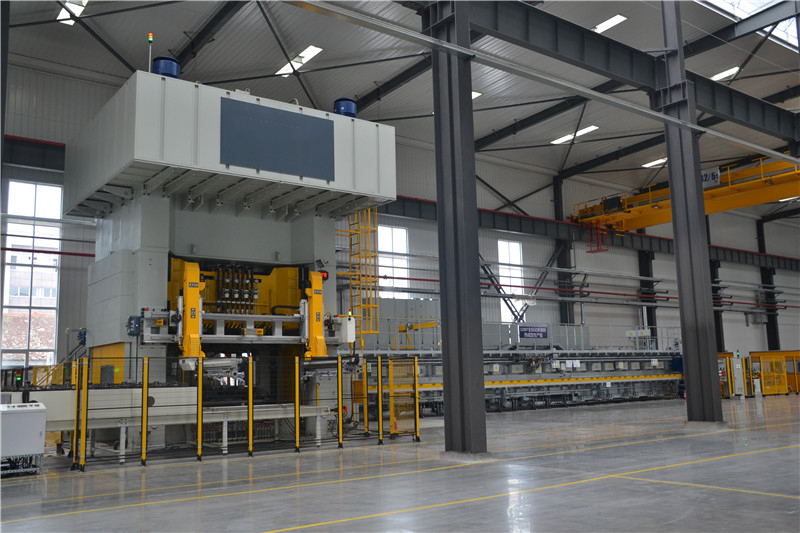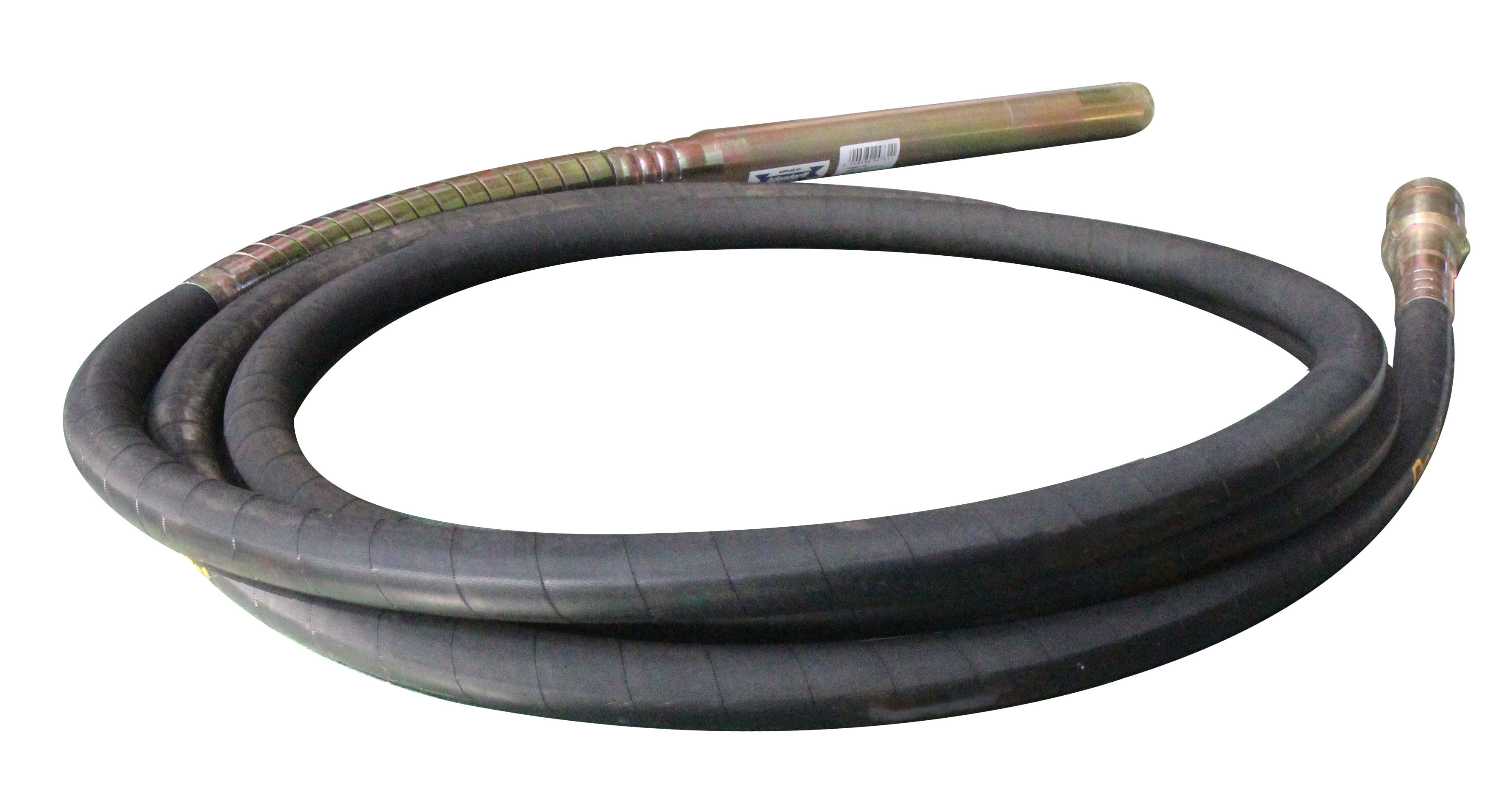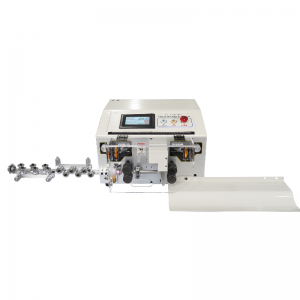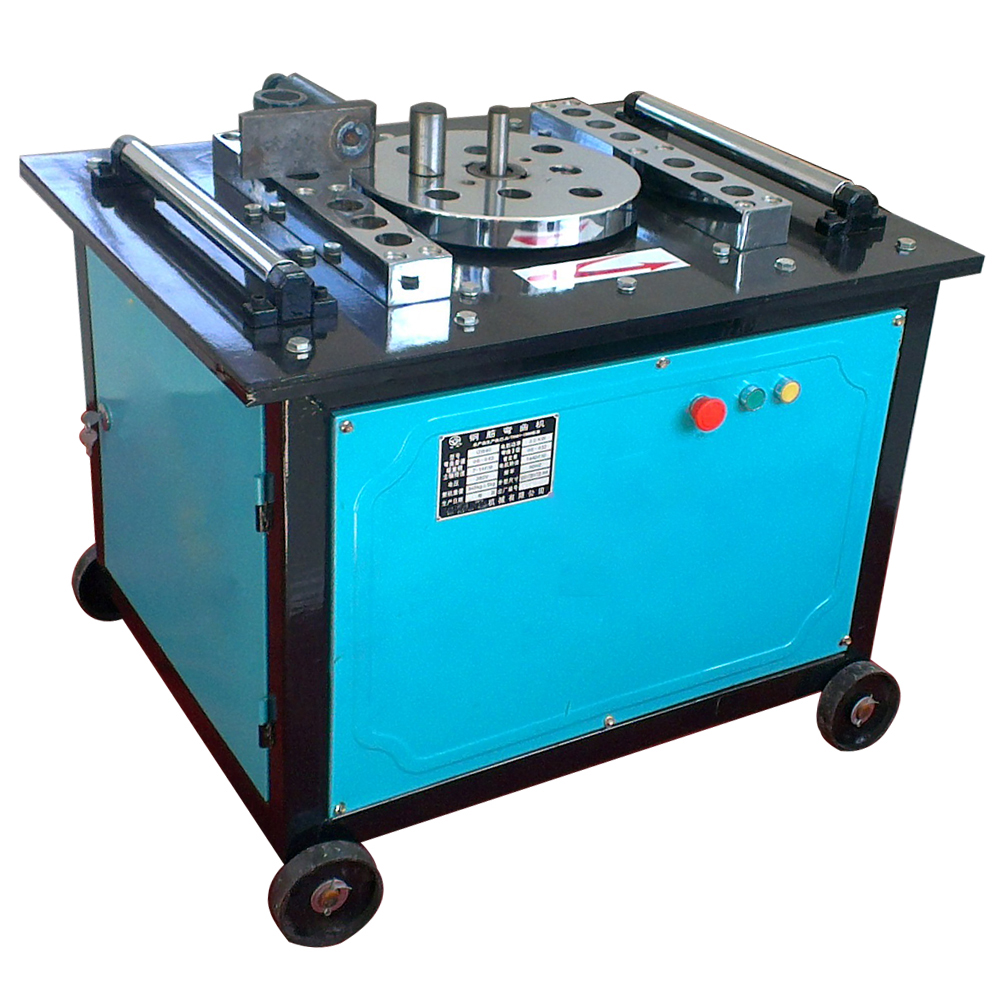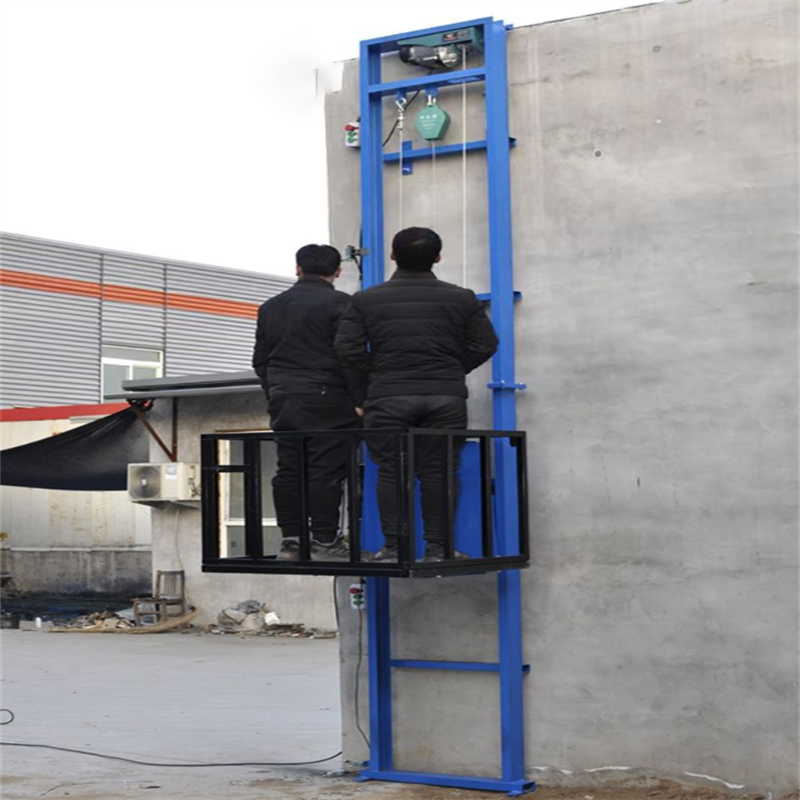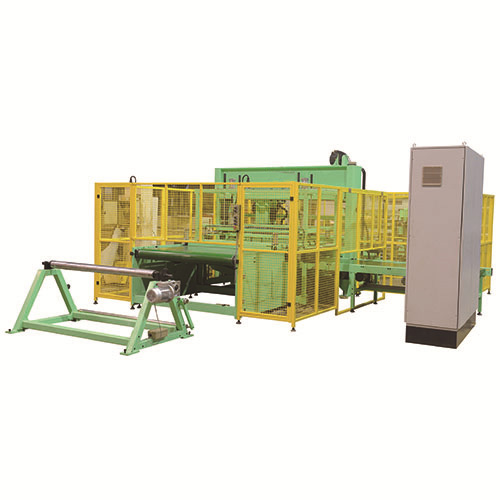The high-speed hot Stamping Production Line for ultral high-Strength Steel (Aluminum)
Key features
The production Line is designed to optimize the manufacturing process of automotive parts through the application of hot stamping technology. This process, known as hot stamping in Asia and press hardening in Europe, involves heating the blank material to a specific temperature and then pressing it in corresponding molds using draulic press technology while maintaining pressure to achieve the desired shape and undergo a phase transformation of the metal material. The hot stamping technique can be classified into direct and indirect hot stamping methods.
Advantages
One of the key advantages of hot-stamped structural components is their excellent formability, which allows for the production of complex geometries with exceptional tensile strength. The high strength of hot-stamped parts enables the use of thinner metal sheets, reducing the weight of components while maintaining structural integrity and crash performance. Other advantages include:
Reduced Jointing Operations: Hot stamping technology reduces the need for welding or fastening connection operations, resulting in improved efficiency and enhanced product integrity.
Minimized Springback and Warpage: The hot stamping process minimizes undesirable deformations, such as part springback and warpage, ensuring precise dimensional accuracy and reducing the need for additional rework.
Fewer Part Defects: Hot-stamped parts exhibit fewer defects, such as cracks and splitting, compared to cold forming methods, resulting in improved product quality and reduced waste.
Lower Press Tonnage: Hot stamping reduces the required press tonnage compared to cold forming techniques, leading to cost savings and increased production efficiency.
Customization of Material Properties: Hot stamping technology allows for the customization of material properties based on specific areas of the part, optimizing performance and functionality.
Enhanced Microstructural Improvements: Hot stamping offers the capability to enhance the microstructure of the material, resulting in improved mechanical properties and increased product durability.
Streamlined Production Steps: Hot stamping eliminates or reduces intermediate manufacturing steps, resulting in a simplified production process, enhanced productivity, and shorter lead times.
Product Applications
The High-Strength Steel (Aluminum) High-Speed Hot Stamping Production Line finds wide application in the manufacturing of automotive white body parts. This includes pillar assemblies, bumpers, door beams, and roof rail assemblies used in passenger vehicles. Additionally, the use of advanced alloys enabled by hot stamping is being increasingly explored in industries such as aerospace, defense, and emerging markets. These alloys offer the advantages of higher strength and reduced weight that are difficult to achieve through other forming methods.
In conclusion, the High-Strength Steel (Aluminum) High-Speed Hot Stamping Production Line ensures precise and efficient production of complex-shaped automotive body parts. With superior formability, reduced jointing operations, minimized defects, and enhanced material properties, this production line provides numerous advantages. Its applications extend to the manufacturing of white body parts for passenger vehicles and offer potential benefits in aerospace, defense, and emerging markets. Invest in the High-Strength Steel (Aluminum) High-Speed Hot Stamping Production Line to achieve outstanding performance, productivity, and lightweight design advantages in automotive and allied industries
What is hot stamping?
Hot stamping, also known as press hardening in Europe and hot press forming in Asia, is a method of material forming where a blank is heated to a certain temperature and then stamped and quenched under pressure in the corresponding die to achieve the desired shape and induce a phase transformation in the metal material. Hot stamping technology involves heating boron steel sheets (with initial strength of 500-700 MPa) to the austenitizing state, quickly transferring them to the die for high-speed stamping, and quenching the part within the die at a cooling rate greater than 27°C/s, followed by a period of holding under pressure, to obtain ultra-high strength steel components with uniform martensitic structure.
The advantages of hot stamping
Improved ultimate tensile strength and the ability to form complex geometries.
Reduced component weight by using thinner sheet metal while maintaining structural integrity and crash performance.
Decreased need for joining operations like welding or fastening.
Minimized part spring back and warping.
Fewer part defects such as cracks and splits.
Lower press tonnage requirements compared to cold forming.
Ability to tailor material properties based on specific part zones.
Enhanced microstructures for better performance.
Streamlined manufacturing process with fewer operational steps to obtain a finished product.
These advantages contribute to the overall efficiency, quality, and performance of hot stamped structural components.
More details about hot stamping
1.Hot Stamping vs Cold Stamping
Hot stamping is a forming process that is performed after preheating the steel sheet, while cold stamping refers to the direct stamping of the steel sheet without preheating.
Cold stamping has clear advantages over hot stamping. However, it also exhibits some disadvantages. Due to the higher stresses induced by the cold stamping process compared to hot stamping, cold-stamped products are more susceptible to cracking and splitting. Therefore, precise stamping equipment is required for cold stamping.
Hot stamping involves heating the steel sheet to high temperatures before stamping and simultaneously quenching in the die. This leads to a complete transformation of the steel’s microstructure into martensite, resulting in high strength ranging from 1500 to 2000 MPa. Consequently, hot-stamped products exhibit higher strength compared to cold-stamped counterparts.
2.Hot Stamping Process Flow
Hot stamping, also known as “press hardening,” involves heating a high-strength sheet with an initial strength of 500-600 MPa to temperatures between 880 and 950°C. The heated sheet is then quickly stamped and quenched in the die, achieving cooling rates of 20-300°C/s. The transformation of austenite into martensite during quenching significantly enhances the strength of the component, allowing the production of stamped parts with strengths of up to 1500 MPa.Hot stamping techniques can be classified into two categories: direct hot stamping and indirect hot stamping:
In the direct hot stamping, the preheated blank is directly fed into a closed die for stamping and quenching. Subsequent processes include cooling, edge trimming and hole punching (or laser cutting), and surface cleaning.
Fiture1: hot stamping processing mode–direct hot stamping
In the indirect hot stamping process, the cold forming pre-shaping step is performed before entering the stages of heating, hot stamping, edge trimming, hole punching, and surface cleaning.
The main difference between indirect hot stamping and direct hot stamping processes lies in the inclusion of the cold forming pre-shaping step before heating in the indirect method. In direct hot stamping, the sheet metal is directly fed into the heating furnace, while in indirect hot stamping, the cold-formed pre-shaped component is sent into the heating furnace.
The process flow of indirect hot stamping typically involves the following steps:
Cold forming pre-shaping–Heating-Hot stamping–Edge trimming and hole punching-Surface cleaning
Fiture2: hot stamping processing mode–indirect hot stamping
3.The main equipment for hot stamping includes a heating furnace, hot forming press, and hot stamping molds
Heating Furnace:
The heating furnace is equipped with heating and temperature control capabilities. It is capable of heating high-strength plates to the recrystallization temperature within a specified time, achieving an austenitic state. It needs to be able to adapt to large-scale automated continuous production requirements. As the heated billet can only be handled by robots or mechanical arms, the furnace requires automated loading and unloading with high positioning accuracy. Additionally, when heating non-coated steel plates, it should provide gas protection to prevent surface oxidation and decarbonization of the billet.
Hot Forming Press:
The press is the core of the hot stamping technology. It needs to have the ability for fast stamping and holding, as well as be equipped with a rapid cooling system. The technical complexity of hot forming presses far exceeds that of conventional cold stamping presses. Currently, only a few foreign companies have mastered the design and manufacturing technology of such presses, and they are all dependent on imports, making them expensive.
Hot Stamping Molds:
Hot stamping molds perform both forming and quenching stages. In the forming stage, once the billet is fed into the mold cavity, the mold quickly completes the stamping process to ensure the completion of part formation before the material undergoes the martensitic phase transformation. Then, it enters the quenching and cooling stage, where the heat from the workpiece inside the mold is continuously transferred to the mold. Cooling pipes arranged within the mold instantly remove heat through the flowing coolant. The martensitic-austenitic transformation begins when the workpiece temperature drops to 425°C. The transformation between martensite and austenite ends when the temperature reaches 280°C, and the workpiece is taken out at 200°C. The role of the mold’s holding is to prevent uneven thermal expansion and contraction during the quenching process, which could result in significant changes in the shape and dimensions of the part, leading to scrap. Additionally, it enhances the thermal transfer efficiency between the workpiece and the mold, promoting rapid quenching and cooling.
In summary, the main equipment for hot stamping includes a heating furnace for achieving the desired temperature, a hot forming press for fast stamping and holding with a rapid cooling system, and hot stamping molds that perform both forming and quenching stages to ensure proper part formation and efficient cooling.
The quenching cooling speed not only affects the production time, but also affects the conversion efficiency between austenite and martensite. The cooling rate determines what kind of crystalline structure will be formed and is related to the final hardening effect of the workpiece. The critical cooling temperature of boron steel is about 30℃/s, and only when the cooling rate exceeds the critical cooling temperature can the formation of martensitic structure be promoted to the greatest extent. When the cooling rate is less than the critical cooling rate, non-martensitic structures such as bainite will appear in the workpiece crystallization structure. However, the higher the cooling rate, the better, the higher the cooling rate will lead to the cracking of the formed parts, and the reasonable cooling rate range needs to be determined according to the material composition and process conditions of the parts.
Since the design of the cooling pipe is directly related to the size of the cooling speed, the cooling pipe is generally designed from the perspective of the maximum heat transfer efficiency, so the direction of the designed cooling pipe is more complex, and it is difficult to obtain by mechanical drilling after the completion of the mold casting. In order to avoid being restricted by mechanical processing, the method of reserving water channels before mold casting is generally selected.
Because it works for a long time at 200℃ to 880~950℃ under the severe cold and hot alternating conditions, the hot stamping die material must have good structural rigidity and thermal conductivity, and can resist the strong thermal friction generated by the billet at high temperature and the abrasive wear effect of the dropped oxide layer particles. In addition, the mold material should also have good corrosion resistance to the coolant to ensure the smooth flow of the cooling pipe.
Trimming and piercing
Because the strength of the parts after hot stamping reaches about 1500MPa, if the press cutting and punching are used, the equipment tonnage requirements are larger, and the die cutting edge wear is serious. Therefore, laser cutting units are often used to cut edges and holes.
4.Common grades of hot stamping steel
Performance before stamping
Performance after stamping
At present, the common grade of hot stamping steel is B1500HS. The tensile strength before stamping is generally between 480-800MPa, and after stamping, the tensile strength can reach 1300-1700MPa. That is to say, the tensile strength of 480-800MPa steel plate, through hot stamping forming, can get the tensile strength of about 1300-1700MPa parts.
5.The use of hot stamping steel
The application of hot-stamping parts can significantly improve the collision safety of the automobile and realize the lightweight of the automobile body in white. At present, hot stamping technology has been applied to the white body parts of passenger cars, such as the car, A pillar, B pillar, bumper, door beam and roof rail and other parts.See figure 3 below for example parts suitable for light-weighting.
figure 3:White body components suitable for hot stamping
Fig. 4: 1200 Ton Hot Stamping Press Line
At present, hot stamping draulic press production line solutions have been very mature and stable, in China’s hot stamping forming field belongs to the leading level, and as the China Machine Tool Association forging machinery branch vice chairman unit as well as the member units of China Forging Machinery Standardization Committee, we have also undertaken the research and application work of the national super high speed hot stamping of steel and aluminum, which has played a huge role in promoting the development of the hot stamping industry in China and even the world.
